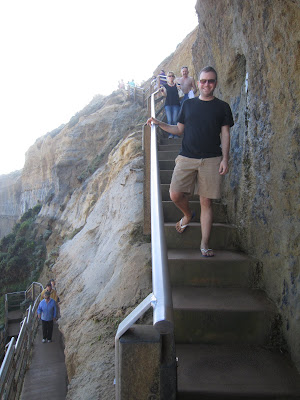Liz and I awoke early on a Wednesday morning to start our two-day trek along the Great Ocean Road. The Great Ocean Road is a 150+ mile stretch of road that hugs the coast between Torquay and Warrnambool, Victoria. It’s a two-lane winding road that has some of the most spectacular coastal views in Australia. Having the word “great” in the name is absolutely appropriate as we were soon to find out. So, we packed up our car and headed out, stopping of course for a quick photo op:
Yes, we stopped and took many photos of signs along the way – mainly because Liz is a photo op monster (which I now appreciate) – but the real photos were the ones of the scenery. And there was lots of scenery, especially on day one.
Our first stop off was the Bay of Islands – photo taken from afar:
Then on to the Bay of Martyrs:
The Grotto:
And the very famous London Bridge:
The island in the bay there used to be attached to the mainland on the left – that is until January 15, 1990, when the arch known as London Bridge came tumbling down into the water, cutting the rock off from the mainland and stranding two tourists on the newly formed island. After several days stranded without water and no way to get off the big rock, the couple died of dehydration.
Actually, they didn’t. Just kidding! They were rescued by helicopter a few hours later. Bet that makes for one hell of a story to tell their friends and kids one day!
The Razorback was a very interesting rock formation – the two sides eroded away by wave action, the Razorback was very thin, nearly as thin as… say… a razor? Yes. But the Razorback is actually called the Razorback because the top (back) of the formation is sharp like a razor due to the salty wind-blown sea spray hardening sections of the top.
The coast along the Great Ocean Road is known as the Shipwreck Coast due to the high number of shipwrecks that occurred before modern navigation equipment came into play. The Loch Ard is one of those ships that hit the rocks and sank. All but two of the passengers perished with the ship in 1878 after a three-month voyage from London to Melbourne. The two survivors were washed into this gorge, which is now appropriately known as the Loch Ard Gorge. Liz and I walked down into the gorge and pretended we were the two survivors!
Actually, we didn’t pretend at all – we just explored the beach a bit, but it would have been totally fun to role play.
Or not.
The next stop was the big stop – the most famous geological feature on the whole Great Ocean Road: the Twelve Apostles!
The Twelve Apostles are twelve limestone stacks in close proximity to each other. Actually, allow me to correct myself: the Twelve Apostles were twelve limestone stacks in close proximity to each other. As with all good things, the Twelve Apostles must come to an end, and the constant battering of waves against the easily-erodable limestone will ensure that. With the most recent collapse of one in 2005, only 8 of the original 12 apostles remain. Which one is next? It’s just like Survivor: the suspense is killing me!
Erosion in action (nerd alert!):
Our final big rocky cliff seaside viewpoint was the Gibson Steps. The Gibson Steps were carved into the cliff side in the late 19th century and covered with concrete for safety at a much later date.
It’s a quick walk down:
And at the end lies a fantastic beach:
With all of this natural beauty, it’s difficult to be anything but happy when taking in the views on the Great Ocean Road. But as any good pessimist will tell you, the happy bubble can burst in the blink of an eye. And that blink happens when you read any one of the many signs that constantly serve to remind you that at any given moment during your visit to the Great Ocean Road, there’s a chance that you will DIE.
I think I’ll take a few steps back from the edge now.













No comments:
Post a Comment